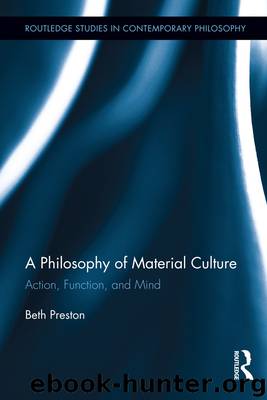A Philosophy of Material Culture by Preston Beth

Author:Preston, Beth.
Language: eng
Format: epub
Publisher: Taylor & Francis (CAM)
ME:
Is this E major we’re talking about?
NORTON:
E major, yeah. Well, E minor is pretty close, too. But, yeah, E major to me is that kind of chord. So I found the chords that for me sounded like a planetary, kind of more ethereal song. And then once I found some chords, I started writing with those chords.
Here, Norton has a particular kind of sound in mind, and proliferates and selects chords in light of that. But in so doing she is also operating in terms of cultural practices governing musical structure—major and minor modes, for instance, and keys. It should be noted that an agent does not necessarily have to be able to explicitly formulate such practices in order to use them effectively. Russ Hallauer, who has no formal training in music, makes this clear:
There were years when I first started playing in bands where I would just kind of know where to put my hands. I wouldn’t exactly know, if someone asked me, what key I was in. I would be like, ‘I have no idea. Here’s where my hands are.’
Nor is it always the case that these practices are adhered to slavishly, as Mamie Fike Simonds reports about a typical exchange with Kelly Noonan in practice sessions:
She’s like, ‘Okay, well, what chord is it?’ And I’m going, ‘Well, it’s just this chord right here I made up. It’s not really a chord.’ And then she’ll say, ‘Well, where’s the chorus?’ ‘Well, it’s not really a chorus, it’s just this part right here that you could call a chorus if you want’ … So she’ll tell me that my songs are disjointed, or whatever, and then she’ll take it and make it into ‘This is your chorus, this is …’ So that helps me.
It should be noted that of all the songwriters I talked to, Fike Simonds is probably the one with the most formal training. So deviations from standard Western musical practices in her songwriting are more likely to reflect creative bending of the ‘rules,’ not lack of knowledge. Nevertheless, she indicates at the end of this passage a willingness to have her contributions taken back in the direction of the standard practices, although she does not say why. Miria, who also often writes songs that do not have standard structures, reports a similar experience with her producer. But she does explain why, in her case, it sometimes makes sense to let her work be revised back in the direction of conformity with more standard song structures:
Usually he’s very much keeping commercial possibilities in mind, and trying to get my songs to fit in a more traditional song structure. And obviously if I were working with a different producer the outcome would be somewhat different. For instance, Alanis Morissette and Glen Ballard—Ballard doesn’t have her do that. And a lot of her songs are not in any way the traditional song structure, and they’re working within that. Arguably some songs are going to be easier for people to
Download
This site does not store any files on its server. We only index and link to content provided by other sites. Please contact the content providers to delete copyright contents if any and email us, we'll remove relevant links or contents immediately.
| Computer Vision & Pattern Recognition | Expert Systems |
| Intelligence & Semantics | Machine Theory |
| Natural Language Processing | Neural Networks |
Algorithms of the Intelligent Web by Haralambos Marmanis;Dmitry Babenko(9831)
Test-Driven Development with Java by Alan Mellor(7637)
Data Augmentation with Python by Duc Haba(7524)
Principles of Data Fabric by Sonia Mezzetta(7295)
Learn Blender Simulations the Right Way by Stephen Pearson(7217)
Microservices with Spring Boot 3 and Spring Cloud by Magnus Larsson(7048)
RPA Solution Architect's Handbook by Sachin Sahgal(6448)
Jquery UI in Action : Master the concepts Of Jquery UI: A Step By Step Approach by ANMOL GOYAL(6446)
The Infinite Retina by Robert Scoble Irena Cronin(6150)
Hadoop in Practice by Alex Holmes(6135)
Big Data Analysis with Python by Ivan Marin(5880)
Life 3.0: Being Human in the Age of Artificial Intelligence by Tegmark Max(5474)
Pretrain Vision and Large Language Models in Python by Emily Webber(4831)
Infrastructure as Code for Beginners by Russ McKendrick(4613)
WordPress Plugin Development Cookbook by Yannick Lefebvre(4331)
Functional Programming in JavaScript by Mantyla Dan(4215)
The Age of Surveillance Capitalism by Shoshana Zuboff(4207)
Embracing Microservices Design by Ovais Mehboob Ahmed Khan Nabil Siddiqui and Timothy Oleson(4103)
Applied Machine Learning for Healthcare and Life Sciences Using AWS by Ujjwal Ratan(4082)
